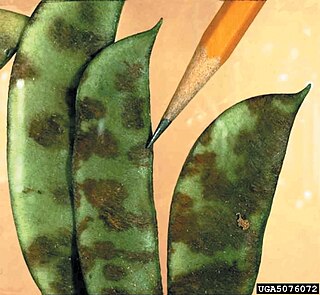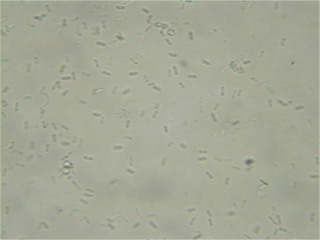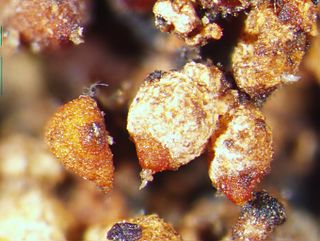
Septoria are ascomycete pycnidia-producing fungi that cause numerous leaf spot diseases on field crops, forages and many vegetables including tomatoes which are known to contract Septoria musiva from nearby cottonwood trees, and is responsible for yield losses. The genus is widespread, and estimated to contain 1072 species. Pycnidia produce needle-like pycnidiospores.

Dothideomycetes is the largest and most diverse class of ascomycete fungi. It comprises 11 orders 90 families, 1,300 genera and over 19,000 known species. Wijayawardene et al. in 2020 added more orders to the class.

Botryosphaeria dothidea is a plant pathogen that causes the formation of cankers on a wide variety of tree and shrub species. It has been reported on several hundred plant hosts and on all continents except Antarctica. B. dothidea was redefined in 2004, and some reports of its host range from prior to that time likely include species that have since been placed in another genus. Even so, B. dothidea has since been identified on a number of woody plants—including grape, mango, olive, eucalyptus, maple, and oak, among others—and is still expected to have a broad geographical distribution. While it is best known as a pathogen, the species has also been identified as an endophyte, existing in association with plant tissues on which disease symptoms were not observed. It can colonize some fruits, in addition to woody tissues.

Phaeosphaeria nodorum is a major fungal pathogen of wheat, causing the disease Septoria nodorum blotch. It is a member of the Dothideomycetes, a large fungal taxon that includes many important plant pathogens affecting all major crop plant families.

Colletotrichum is a genus of fungi that are symbionts to plants as endophytes or phytopathogens. Many of the species in this genus are plant pathogens, but some species may have a mutualistic relationship with hosts.

The Pleosporales is the largest order in the fungal class Dothideomycetes. By a 2008 estimate, it contained 23 families, 332 genera and more than 4700 species. The majority of species are saprobes on decaying plant material in fresh water, marine, or terrestrial environments, but several species are also associated with living plants as parasites, epiphytes or endophytes. The best studied species cause plant diseases on important agricultural crops e.g. Cochliobolus heterostrophus, causing southern corn leaf blight on maize, Phaeosphaeria nodorum causing glume blotch on wheat and Leptosphaeria maculans causing a stem canker on cabbage crops (Brassica). Some species of Pleosporales occur on animal dung, and a small number occur as lichens and rock-inhabiting fungi.

The Mycosphaerellaceae are a family of sac fungi. They affect many common plants, such as eucalyptus, the myrtle family, and the Proteaceae. They have a widespread distribution.

The Botryosphaeriaceae are a family of sac fungi (Ascomycetes), which is the type representative of the order Botryosphaeriales. According to a 2008 estimate, the family contains 26 genera and over 1500 species. Members of this order include notable plant pathogens.

Phoma is a genus of common coelomycetous soil fungi. It contains many plant pathogenic species.

The Massarinaceae are a family of fungi in the order Pleosporales. Although taxa have a cosmopolitan distribution, they are better-known in temperate regions. They are thought to be saprobic in wood and bark; some species are weak pathogens.

Corallomycetella is a genus of ascomycete fungi in the family Nectriaceae. Species of Corallomycetella are tropical, and are characterized by the formation of brightly colored rhizomorphs of their rhizostilbella-like asexual morphs. These fungi causes a number of plant diseases including 'violet root rot' of Theobroma cacao, root rot of Carica papaya, and 'stinking root disease' of several tropical woody plants. Two species of Corallomycetella are recognized: Corallomycetella elegans C. Herrera & P. Chaverri and Corallomycetella repens Rossman & Samuels. Corallomycetella jatrophae is now classified under Corallonectria.
Stagonosporopsis is a genus of ascomycote fungi, containing several pathogens to plants.

André Aptroot is a Dutch mycologist and lichenologist. His primary research focus is on biodiversity, particularly tropical lichens, encompassing systematics, floristic surveys, and taxonomic reviews. A prolific researcher, he has published more than 500 scientific papers and described hundreds of new fungal and lichen species.

The Didymellaceae are a family of fungi in the order Pleosporales. They have a world-wide distribution.

Corallonectria is a genus of ascomycete fungi in the family Nectriaceae. Species of Corallonectria are Neotropical. These fungi are characterized by the formation of brightly colored rhizomorphs and of copulated synnematous fusarium-like asexual morphs in culture. The asexual morph in nature has been rarely observed. The sexual fruiting bodies are furfuraceous and usually seated at the base of a reddish synnemata. It is a monotypic genus containing the sole species Corallonectria jatrophae. This species was formerly classified under Corallomycetella.

Cordieritidaceae is a family of fungi in the order Cyttariales. Species in this family are saprobes or lichenicolous.
The Lentitheciaceae are a family of fungi in the order of Pleosporales. They are found world-wide with the greatest contributions found in Europe and Australia.

Xenodevriesia strelitziicola is a pathogenic ascomycete fungus in the class Dothideomycetes that infects the South African plant Strelitzia. It is the only species of the monotypic genus Xenodevriesia and family Xenodevriesiaceae.

Coniothyriaceae is a family of ascomycetous marine-based fungi within the order of Pleosporales in the subclass Pleosporomycetidae and within the class Dothideomycetes. They are pathogenic or they can be saprobic on dead branches. They are generally a anamorphic species.

Neocamarosporium is a genus of ascomycete fungi, as accepted by Wijayawardene et al. 2020. The species are typically halotolerant, being commonly found in saline environments like in saline water, hypersaline soils and especially in association with halophytes.


















